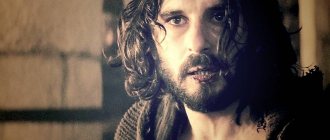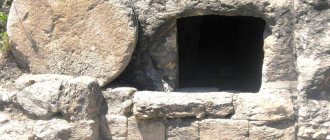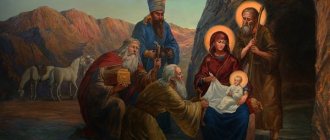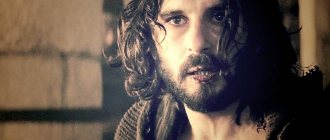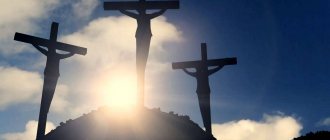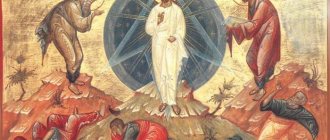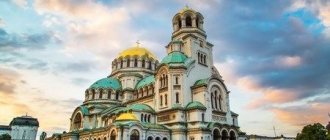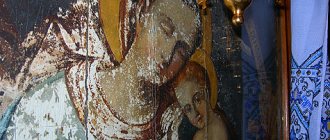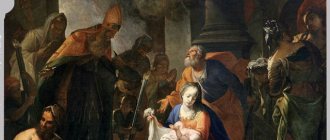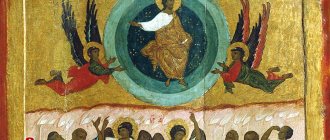Rare and unusual icons
"The First Steps of Jesus."
The icon is located in the monastery of St. Gerasim of Jordan. Monastery of St. Gerasimos of Jordan was founded in the 5th century in the south of the Jordan Valley near the confluence of the Jordan River with the Dead Sea and where the Holy Family stopped on the way to Egypt, by Gerasimos, who came to the Holy Land to worship and settled here as a hermit.
Other monks joined St. Gerasim and a monastery was built for their living. In it, the monks lived in a dormitory and, having achieved spiritual perfection, settled in separate cells.
They say about Gerasim that he reached an incredible level of asceticism and during the Forty Day Lent he went without food at all, being content only with the bread of Holy Communion on Sundays.
The Monk Gerasim died in 475 and in his modesty did not leave the site of his grave.
There are two churches in the monastery - Upper and Lower. At the bottom there is a cave in which the baby Jesus, Mary and Joseph spent the night on their way to Egypt.
Orthodox pilgrims serve a prayer service in the church.
The monastery cultivates symbolism associated with the image of a lion.
During his travels through the desert, Gerasim found a huge lion whose paw was damaged. The monk healed the beast and the lion became attached to him, becoming his faithful servant. For many years the three of them lived together with the donkey that lived with Gerasim. Animals carried water from the Jordan, helped in the work and protection of the hermit’s home, which served as an example of how animals obeyed man in paradise.
There is an instructive story about how a donkey once stayed with a lion, when Gerasim was away for a long time, stuck to a caravan passing by and left.
Gerasim, returning, found only one lion, and was sure that he had eaten his friend. For a whole year, the lion alone did all the work and bore the heavy burden of his master’s mistrust. A year later, that caravan again passed by the cell of the holy hermit, and the donkey, recognizing his native place, returned to his friends alive and well...
The monastery of Gerasimos of Jordan is associated with a parable about the Venerable Mary of Egypt, a former harlot who went on a pilgrimage to the Holy Land and repented before entering the Holy Sepulcher. Obeying a voice from above, she went to the Jordan desert for solitude and repentance, where she spent 47 years. Only three times did she meet a person during this time, and this person was Hieromonk Zosima, who lived in the monastery of St. Gerasima. Zosima had the fate of learning about the life of the saint from her lips, giving her communion and burying her ashes in the desert.
The residents of the monastery welcome pilgrims extremely cordially. They have delicious crackers, sweets, and juices prepared on the table.”
We advise you to familiarize yourself with the pictures of prayer and church with several options in Russian, with full descriptions and pictures.
Transfiguration of the Lord on the Mount in the Gospel of Matthew and Mark
The story of the Transfiguration of the Lord on the Mount shows us that the ministry of Jesus Christ (the gospel) complements the ministry of Moses (the law) and the ministry of Elijah (the prophets), being superior to them.
Then the disciples asked Him: “Why do the teachers of the law say that Elijah must come first?” Jesus answered them: “It is known that Elijah must come and restore order to everything. But I tell you, Elijah has already come, but the people did not recognize him and treated him badly. In the same way the Son of Man will suffer at their hands.” And then they realized that He was telling them about John the Baptist. (Gospel of Matthew 17:10-13)
Yes, this is the same Elijah spoken of in the Old Testament and in whose spirit John the Baptist prepared the way for the Lord.
And Jesus said: “Truly I say, some of those standing here will see the kingdom of God in full power before they die.” Six days later Jesus took Peter, James and John and led them alone up a high mountain. And He was transfigured before them. His robe became dazzlingly white, like no washerwoman on earth could bleach. And then two people appeared, they were Elijah and Moses, and began to talk with Jesus.
Peter spoke to Jesus: “Teacher! It’s good that we are here, let’s set up three tents: one for You, one for Moses and one for Elijah.” Peter said this because he did not know what to do, since the disciples were in great fear. Then a cloud appeared and covered them with its shadow, and a voice came from the cloud: “This is My Beloved Son. Listen to Him! And immediately, looking around, they saw no one else next to them except Jesus. As they descended from the mountain, He told them not to tell anyone what they had seen until the Son of Man rose from the dead. (Mark 9:1-9)
Douglas Jacoby
Image of Christ
Early Christianity
The earliest Christian writers did not describe the appearance of Jesus Christ. The leading theologian of the 2nd century, Irenaeus of Lyon, quoting the Apostle John, expressed the idea of the Church Fathers about the role of the incarnation of Christ: “The Word of God became flesh ... to destroy death and give life to man.” However, it is worth noting that the above words apparently mean the Incarnation as such.
In the New Testament, many perceive Christ as an ordinary person, a wanderer, the son of a simple carpenter: “Isn’t this the son of Joseph?” (Luke 4:22), “Is not this the carpenter, the son of Mary, the brother of James, Josiah, Judas and Simon?” (Mark 6:3) Therefore, He is accused of blasphemy for calling Himself the Son of God (Mark 14:61-62).
It is also worth noting that the Roman philosopher of the 2nd century Celsus, in his work “The Truthful Word” (2nd half of the 2nd century), among his critical statements about Christianity, briefly mentioned the appearance of Jesus: “Since the body had the spirit of God, it should have been would be sharply different from others in height, beauty, strength, voice, ability to amaze or convince; for it is impossible for something that contains more of the divine to be no different from another; and yet she was no different from others and, as they say, did not stand out for her height, beauty, or slenderness.” This indicates that the early Christians also considered the image of Christ to be human.
The father of church history, Eusebius Pamphilus, at the turn of the 3rd-4th centuries, talking about the bronze statue of Christ he saw, spoke disapprovingly of the images of Christ and the Apostles: “I told you that images of Paul, Peter and Christ Himself, painted on boards, have been preserved. Naturally, the ancients were accustomed, without much thought, according to pagan custom, to honor their saviors in this way.”
Irenaeus of Lyon, criticizing the Carpocratian movement, mentions images of Christ:
“They... have images partly painted, partly made from other materials, saying that the image of Christ was made by Pilate at the time when he lived with people. And they decorate them with crowns and display them together with images of secular philosophers, namely with the image of Pythagoras, Plato, Aristotle and others; and show them other signs of respect, just like the pagans.”
However, he may have criticized the fact that the image of Christ is placed together with images of pagan philosophers and the pagan manner of worship.
The legend about the creation of the first portrait of Jesus Christ was conveyed by one of the Church Fathers, John of Damascus:
“King Abgar, who reigned in the Ostroen city of Edessa, sent a painter to paint a similar image of the Lord. When the painter could not do this due to the shining brilliance of His face, the Lord himself, applying a piece of matter to His divine and life-giving face, imprinted His image on a piece of matter and, under such circumstances, sent it to Abgar at his request.”
Descriptions of Christ’s appearance were preserved from the stories of “savidos” even by the 4th–9th centuries. developed into detailed texts that coincide in basic details. However, in the 8th century, a religious and political movement against the veneration of icons and other images of Christ and saints (iconoclasm) gained strength. Iconoclasts considered sacred images to be idols, and the cult of veneration of icons to be idolatry, referring to the Old Testament commandments: “You shall not make for yourself an idol or any image of anything that is in heaven above... do not worship them or serve them” (Ex. 20:4-5) . In 730, the Byzantine emperor Leo III the Isaurian banned the veneration of icons. The result of iconoclasm was the destruction of thousands of icons, mosaics, frescoes and statues of saints in many churches, and icon worshipers were also persecuted.
It is worth noting that in the Old Testament it was forbidden to depict foreign gods. For example, images of cherubim in the Temple were allowed (Ex. 26:1, Ezek. 41:17-25). The Old Testament also forbade depicting God because people did not see His Image: “Keep it firmly in your souls that you did not see any image in the day that the Lord spoke to you” (Deut. 4:15). That is, it was forbidden to give free rein to your imagination and come up with an image of God, Whom no one had seen. Also in the New Testament, Jesus Christ says: “Truly I say to you, many prophets and righteous men desired to see what you see, and did not see, and to hear what you hear, and did not hear.” (Matt. 13:17).
At the VII Ecumenical Council in 787, the dogma of the universal Christian Church was established - veneration of icons. The main idea of veneration of icons is: “The honor given to the image goes to the Archetype.”
Canonical appearance
In Christian literature there are several descriptions of the appearance of Christ, generally reproducing the same basic type. In painting, this type was somewhat modified in accordance with the development of iconography and under the influence of local conditions. The earliest description is believed to be from the proconsul of Judea, Publius Lentulus, predecessor of Pontius Pilate. In his letter to the Roman Senate, Lentulus writes about Jesus Christ:
“This man is tall, important and has an appearance full of dignity, so that he inspires fear and love in those who look at him at the same time. The hair on his head is smooth, darkish in color (chestnut), falling from his shoulders in strands and parted in the middle, according to the custom of the Nazarenes. His forehead is open and smooth, there are no spots or wrinkles on his face, his complexion is slightly reddish. The beard is red and thick, not long, but forked. The eyes are blue and unusually shiny. His figure is tall, his arms are straight and long, his shoulders are beautiful. His speech is thoughtful, faithful and restrained. This is the most beautiful of earthly creatures."
The entire style of the letter does not correspond to the message of the Roman governor and betrays its Christian origin, although it is not possible to determine the exact date of its composition. The document itself was found in a Latin translation in a manuscript between the writings of Anselm of Canterbury, an 11th-century archbishop and theologian, but historians have no doubt about its much earlier Greek origins. Also, the procurator of Judea named Publius Lentulus is unknown from other sources, and Pilate’s predecessor was Valerius Gratus.
A similar description of Christ was given by the Constantinople monk Epiphanius in “The Life of Andrew the First-Called” (first half of the 9th century)
The Savior “was very beautiful in appearance (as the prophet says (Ps. 44:3): “beautiful in kindness than the sons of men”), and in height or bodily elevation of six full feet; having light brown hair and not particularly thick, more like ears of corn; the eyebrows are black and not particularly bent; eyes bright and shining (just as the story tells about His forefather David (I Book of Kings, XVII, 42): “He was the child, and the black one and the mouth of his eyes" (Ps. 44:3); like this) red-eyed , with a long nose, with a brown hair, having long hair - for never a razor touched His head, nor a human hand, except His Mother, in His childhood; with a slight inclination of the neck, so much so that it is not quite straight to hold Him at full height; wheat-colored body, the face is not round, but like His Mother’s, slightly tapering towards the bottom, slightly covered with a blush, so much so as to show a pious and reasonable disposition and gentle custom and in all things wrathless goodness, which the Word recently described in His Mother, for in To everyone He was likened and equated to Her.”
Sacred History of the New Testament
In. IV:1–42.
After the Passover holiday, Jesus Christ remained for some time in Judea. When the Pharisees, having learned that He was acquiring more disciples than John, began to envy and follow Him, the Lord decided to return to Galilee.
Passing through Samaria, He stopped in the vicinity of the city of Sychar, near a well, which was dug by the will of the Patriarch Jacob. Jesus Christ sat down near this well to rest, and His disciples went to the city to purchase food supplies. At this time a woman came from the city to fetch water. When she drew water, the Lord turned to her and said:
- Give me something to drink.
The woman was extremely amazed at His request; for the Jews, due to their irreconcilable hatred of the Samaritans, considered any relationship with them to be a sin.
“How do you, being a Jew,” she exclaimed, “ask me, a Samaritan woman, for a drink?”
“If you knew the gift of God and who says to you: “Give Me a drink,” answered the Lord, “then you yourself would ask Him, and He would give you living water.”
- Master! - the Samaritan woman objected, - you have nothing to draw with, and the well is deep: where do you get living (spring) water? Are you greater than our father Jacob, who gave us this well, and who drank from it, and his children, and his cattle?
Jesus Christ, explaining his previous words, continued:
“Everyone who drinks this water will thirst again; and whoever drinks the water that I will give him will never thirst; but the water that I will give him will become in him a fountain of water springing up into eternal life.
The woman, not understanding that this life-giving source is Jesus Christ himself and His teaching, began to ask:
- God! Give me this water so that I won’t be thirsty and won’t have to come here to draw.
“Go, call your husband and come here,” the Lord said to her.
“I don’t have a husband,” answered the Samaritan woman.
The Lord, wanting to show His omniscience and give a proper understanding of Himself to the interlocutor, remarked to her:
– You said the truth that you don’t have a husband. For you have had five husbands; and the one you have now is not your husband; That's right what you said.
- God! “I see that You are a prophet,” the Samaritan woman exclaimed in amazement. At the same time, a desire immediately appeared in her to learn from Him the solution to the long-standing dispute between the Samaritans and the Jews regarding the place of worship. The Samaritans built a temple for themselves on Mount Gerizin, and the Jews destroyed it, arguing that nowhere should one worship the true God except in Jerusalem. The ruins of the destroyed temple now lay right before the eyes of Jesus Christ and the woman who was talking to Him, and therefore she turned to the Lord with these words:
“Our fathers worshiped on this mountain, but you say that the place where they should worship is in Jerusalem.”
“Believe Me that the time is coming,” the Lord answered her, “when you will worship the Father neither on this mountain nor in Jerusalem... But the time will come, and has already come, that true worshipers will worship the Father in spirit and truth: for such The Father is looking for fans for Himself. God is spirit: and they that worship him must worship in spirit and in truth.
Listening to such a lofty teaching, the Samaritan woman involuntarily remembered the Messiah, who was supposed to spread the light of true knowledge of God everywhere, and therefore said:
– I know that the Messiah will come, that is, Christ; when He comes, He will explain everything to us.
“It is I who speak to you,” Jesus Christ answered her.
At such an unexpected discovery, the woman was completely confused, left her waterpot and ran into the city. Arriving in Shechem, she said to everyone she met:
- Go and see the man who told me everything I did; Isn't He the Christ?
Many of the Samaritans believed the words of the woman who spoke with Jesus, and, coming to Him, asked Him to stay with them for a while. At their request, Jesus Christ stayed in Sychar for two days and during this time acquired a significant number of believers.
Samaria was located between Judea and Galilee and was the smallest of the four regions of Judea. Despite its mountainous position, it was very fruitful, irrigated by many streams, abounding in good pastures and was very populous. Its inhabitants under Jesus Christ were descendants of the pagans settled there by Shalmaneser after the fall of the kingdom of Israel. These pagans, together with the Israelites who escaped Assyrian captivity, at the very beginning accepted the Law of Moses, formed themselves into a special people - the Samaritans, and formed a special religion for themselves, known among the Jews under the name of the Samara Schism.
The Samaritans differed in faith from the Jews in that, while honoring the law of Moses, they rejected other sacred books and likewise did not recognize the Pharisees' traditions. That is why the Jews, upon their return from Babylonian captivity, began to show contempt to the Samaritans as half-pagans and heretics and did not agree to allow them to participate in the construction of the second temple. The Samaritans, taking advantage of the circumstances, built themselves a special temple on Mount Garizin and established their Divine service, following the example of Jerusalem; but the Jews under John Hyrcanus destroyed it. This gave rise to irreconcilable hostility between both peoples. The Jews hated the Samaritans to such an extent that they considered them worse than the pagans and did not want to recognize them as their fellow countrymen. But Jesus Christ repeatedly poured out His mercy on the Samaritans and even at His Ascension commanded the Apostles to go preaching to Samaria ( Acts 1:8 ). Remnants of the Samaritans still exist in the city of Nablus (ancient Samaria).
Shechem, one of the oldest Palestinian cities, was located 16 hours north of Jerusalem and 18 hours south of Nazareth. It lies in a picturesque valley covered with olive and fig groves, and is surrounded by high mountains, among which Ebal in the north and Garizin in the south are especially distinguished.
In the southeast of the Shechem Valley there is Jacob's well, where Jesus Christ talked with his Samaritan wife. Above the well back in the 7th century. there was a church built in the shape of a cross: a well occupied the middle, and there were entrances on all four sides. It has an irregular hole between large stones and has not dried out yet. The Gospel says that this well was located near the city of Sychar. Some people think that it was a completely different city from Cuxema.
History of iconography
Good Shepherd. Roman marble sculpture, 4th century.
In early Christian times, allegorical images of Christ were often used in the form of a lamb (lamb) (John 1:29), a pelican (a symbol of mercy, tore his chest to feed his chicks with blood), a dolphin (savior of drowning people), pierced by a trident, a lamb under an anchor, symbolizing the cross, fish (ichthys).
Among anthropomorphic images, Orpheus playing the harp, or the “Good Shepherd” - a shepherd carrying a lost sheep on his shoulders - were especially popular. By the decrees of the Fifth-Sixth (Trullo) Council in 692, allegorical images of Christ were prohibited.
Images of Christ close to traditional iconographic images are already known from the Roman catacombs. The iconography of the Savior was developed in the frescoes and mosaics of Christian churches of the Eastern and Western Roman Empires. In icon painting, the first surviving easel images are known from the 6th century, while at the same time tradition dates some images, for example, the Savior Not Made by Hands, to Gospel times.
Required image elements
One of the first images of Jesus Christ with a halo. Fragment of paintings of the Roman catacombs (Commodilla catacombs, 4th century)
The halo in the images of Christ appeared as the Church’s response to the heresy of Arius (see the article Arianism). Most often, Jesus Christ is depicted with a special cross-shaped halo that is unique to Him. Initially, the Greek letters α and ω were used to designate the single essence of the second hypostasis of the Holy Trinity (Rev. 1:8, 1:10, Rev. 21:6, 22:13).
Since the 11th century, the “earthly” name is signed ІС ХС (short for Jesus Christ) to the left and right of the image, and the “heavenly” name is signed in Greek letters ὁ ὢν (from the other Greek. “He who is” in the text of Ex. 3:14 - יהוה - pronounced “Yahweh” or “Jehovah”) in the three visible rays of the cross-shaped halo. In Russian icon painting, Greek letters are often replaced by Cyrillic ones: ѾОН with various interpretations.
After the schism, as a response to the Old Believers’ response to the spelling of the name Jesus with one “i,” innovations in the signature IIS XC appeared among the “ruling” Russian Orthodox Church, which were not widely used.
Traditional clothes of Christ: lower - a purple chiton with a stripe - clave on the shoulder, upper - a blue himation
Basics of Orthodoxy
Baptism is a necessary condition for entering the Church
About the need for baptism
In order for a person to become a Christian, a member of the Orthodox Church, the Sacrament of Baptism must be performed on him. Is this necessary and why is this Sacrament the beginning of life in the Church?
The Sacrament of Baptism was established by the Lord Jesus Christ Himself. We have several testimonies of the Holy Scriptures for this, the main one of which is the words of the Lord to His disciples before He ascended into heaven: Go therefore and teach all nations, baptizing them in the name of the Father and the Son and the Holy Spirit
(Matt. 28:19).
The meaning and significance of baptism
The meaning of the Sacrament of Baptism is the spiritual birth of a person into eternal life. Just as the Lord Jesus Christ voluntarily crucified on the cross for us, died and rose again, so a person who receives the Sacrament of Baptism is crucified, dies spiritually for sins and is resurrected into new life. In the Sacrament, a person is given the special grace of God, original sin is forgiven, as well as all previously committed sins. The Church calls upon the newly baptized person to henceforth live according to the commandments of the Lord, according to the Gospel, and not become a slave of sin again. The Holy Apostle Paul also testifies to this: Do you not know that all of us who were baptized into Christ Jesus were baptized into His death? Therefore we were buried with Him through baptism into death, so that just as Christ was raised from the dead by the glory of the Father, so we too might walk in newness of life.
(Rom. 6:3–4).
From the outside, the Sacrament of Baptism opens the way for a person to a full church life. Having become a Christian, he can proceed to other Sacraments and rituals of the Church, while receiving in them the grace-filled gifts of the Lord. All this leads a person to change his spiritual life for the better, helps him in saving his soul and body.
Preparing for baptism
An important and necessary condition for preparing to receive the Sacrament of Baptism is attending special catechetical (educational) conversations, which in our time are organized at almost every church. Announcement conversations (i.e., for the announcement of those wishing to be baptized) are organized so that those entering the Church, at least at first, become familiar with the fundamentals of the Orthodox faith. These conversations, as a rule, are conducted with those wishing to be baptized either by the clergyman of the temple in which the baptism will take place, or by the teacher of the local Sunday school.
A prerequisite before baptism is to familiarize a person with the basic texts and prayers of the Orthodox Church. Thus, the person being baptized must memorize the Creed
- a text that briefly outlines church doctrine. This Symbol was compiled by the Fathers of the Church back in the first centuries of Christianity and has come down to us without changes, which are strictly forbidden to be introduced into it. In addition, it is advisable that a person also memorize one of the main Christian prayers: “Our Father,” which was given to us by the Lord Jesus Christ Himself, as well as “Rejoice, Virgin Mary,” in which the Mother of God is glorified.
Before accepting baptism, it is necessary to familiarize yourself with the basics of Christian morality, as well as such concepts as virtue, evil, sin, passions.
As church experience testifies, in the days of preparation for baptism, a person must be prepared for some temptations. For example, he may be affected by attacks of laziness, relaxation, irritation, sadness, etc. All this must be endured with dignity, since according to the teachings of the Church, at this time a person, under the guise of all these feelings, can be influenced by fallen spirits of malice who want to turn him away from the most important step in his life.
In the days before receiving the Sacrament, a person should, if possible, distance himself as much as possible from the temptations of the outside world, and, conversely, delve into his inner, spiritual world. Immediately before baptism, it is advisable to observe physical and spiritual fasting for three days, including for those who live in marriage. On the day of receiving the Sacrament of Baptism, you should not eat or drink in the morning (for smokers, smoke). You must come to the temple early, without being late, in clean and proper clothes for the temple. For men this is a shirt, trousers, jacket, and for women - a dress with a decent length hem, a jacket with a skirt, and, of course, a headscarf. It is also advisable that the woman in the temple wear no bright jewelry or makeup. It should be noted that on those days when a woman goes through a natural physiological monthly cycle, she cannot begin the Sacrament of Baptism.
About those being baptized
According to the tradition established in the Orthodox Church, absolutely all people, including children, starting from infancy, are allowed to receive the Sacrament of Baptism. Moreover, it is the Orthodox Church, unlike other Christian denominations, that insists that the Sacrament of Baptism be performed on an infant.
This is due to the fact that a child is already a living person, a creation of God, who also has the right to be a full member of the Church of the Lord Jesus Christ. This is also done in order to avoid the tragic situation when a child may die (for various reasons) without receiving baptism.
Both in the early Christian period and now, the Orthodox Church does not divide people into categories; it admits everyone to the Sacrament of Baptism - both the healthy and the sick; both women and men; young and old.
The main condition that is required from a person is awareness of his choice, a free desire to become a member of the Church, as well as knowledge of the basic Christian doctrinal truths.
God-parents
According to church tradition, a believer, Orthodox by religion, is chosen as a godparent. There may be two godparents, or maybe one. If there is only one godfather, then, as a rule, he is of the same gender as the person being baptized. If there are two godparents - a man and a woman.
In the most extreme case, a priest can become a godfather if no other godparents have been found. The child’s parents can be present when the Sacrament is performed, but then the prayer of the 40th day must be read over the mother.
There are categories of people who, according to the canons of the Church, cannot be godparents - these are monks (nuns), parents for their own children, persons married to each other (or the bride and groom), unbaptized, minors, mentally ill (with mental illness), persons drunk.
When parents choose future adoptees for their child, first of all they should pay attention not to the person’s social status, but to his moral, spiritual and ethical qualities. Indeed, in addition to participating in the Sacrament, the main task of the godparents is to educate their godson in the Orthodox faith. According to the teachings of the Church, godparents will be responsible for their affairs in raising their godson before the Lord God Himself. Simply put, they will be responsible for what kind of Christian their spiritual child grows up to be.
The history of the Sacrament of Baptism and its main stages will be discussed in the corresponding part of the work.

